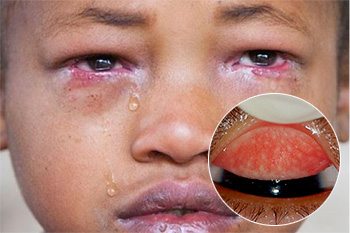Trachoma Causes, Symptoms, Diagnosis and Treatment

What is Trachoma?
Trachoma is the world’s leading cause of preventable blindness of infectious origin (1). Caused by the bacterium Chlamydia trachomatis, trachoma is easily spread through direct personal contact, shared towels and cloths, and flies that have come in contact with the eyes or nose of an infected person. If left untreated, repeated trachoma infections can cause severe scarring of the inside of the eyelid and can cause the eyelashes to scratch the cornea (trichiasis). In addition to causing pain, trichiasis permanently damages the cornea and can lead to irreversible blindness. Trachoma, which spreads in areas that lack adequate access to water and sanitation, affects the most marginalized communities in the world
Causes of Trachoma
Although trachoma is caused by a small parasitic bacteria, poor sanitation, unclean water supply, and reduced personal and community hygiene allow the bacteria to infect and reinfect eyes of individuals living in endemic areas. Prevention of vision loss requires adequate, prompt treatment, in addition to education and teaching proper hygiene to the parents and children.
Symptoms of Trachoma
Signs and symptoms of trachoma usually affect both eyes and may include:
- Mild itching and irritation of the eyes and eyelids
- Discharge from the eyes containing mucus or pus
- Eyelid swelling
- Light sensitivity (photophobia)
- Eye pain
Young children are particularly susceptible to infection. But the disease progresses slowly, and the more painful symptoms may not emerge until adulthood.
Diagnosis of Trachoma
Although there are bacteriologic and other tests available, trachoma is commonly diagnosed by examining the eyes and eyelids of the patient. In the rare cases seen in developed countries, the diagnosis is usually by the ophthalmologist. However, in the third world, ancillary personnel are very capable of being trained to make this diagnosis. Trachoma should be suspected from the history and symptoms. It then can be confirmed by an examination which can be performed within the community without the aid of sophisticated office equipment.
If equipment is available, the vision is measured and the eye is inspected with a slit lamp (bio microscope), with which characteristic changes in the lids, tear film, conjunctiva, and cornea can more easily be seen.
Treatment of Trachoma
Trachoma infection can be prevented through reducing the pool of infection and reducing transmission, often by antibiotics and improved access to water to maintain personal hygiene and sanitation. However, treatment becomes increasingly complex and unsuccessful in the more advanced phases of the disease.
Surgical correction of scarred eyelids also comes with a risk of failure or recurrence because of the progressive scarring caused by trachoma. The Fred Hollows Foundation is part of the International Coalition for Trachoma Control, which advocates for the implementation of the World Health Organisation’s SAFE strategy:
Surgery: To prevent blindness by eyelid surgery to correct inverted eyelashes
Antibiotics: Community wide distribution of antibiotics to treat active infection
Face washing: To stop eye-seeking flies that spread infection
Environment: To give communities access to water and improved sanitation
Related Articles:
5 Foods for the Eyesight and Eye Health
Eye Floaters Causes, Symptoms, Diagnosis and Treatment
Vitamin C – Using Oranges May Cure Eyesight
Eyestrain Causes, Symptoms, Diagnosis and Treatment
Pink Eye (conjunctivitis) Causes, Symptoms, Diagnosis and Treatment
Rapid Eye Movement Sleep Symptoms, Causes, Diagnosis and Treatment
Eye Melanoma Symptoms, Causes, Diagnosis and Treatment
Eye Bags Symptoms, Causes, Diagnosis and Treatment
Dry Eyes Symptoms, Causes, Diagnosis and Treatment
Natural Remedies for Retinal Vein Occlusion to Help Relieve Itchy Eyes
Fungal Eye Infection Causes, Symptoms, Diagnosis and Treatment
By : Natural Health News




